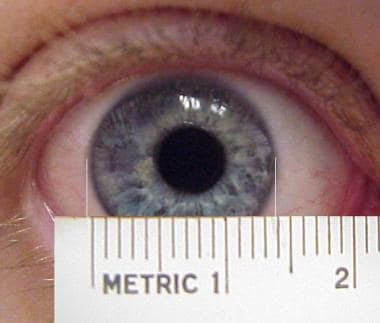Background
Megalocornea is a rare nonprogressive enlargement of the cornea to 13 mm or greater; in the setting of normal intraocular pressure. The cornea and limbus are enlarged, but the cornea itself is histologically normal and of normal thickness. Megalocornea is usually seen as an isolated finding, known as simple isolated megalocornea. It may be associated with other ocular and systemic findings, including megophthalmos anterior and/ or dysgenesis of the iris, lens, and ciliary body.
Megalocornea is shown in the image below.
Pathophysiology
Megalocornea is a developmental anomaly of unknown etiology. Postulated mechanisms of development include a defect in formation of the optic cup in which the anterior tips of the cup fail to fuse, allowing more space for the developing cornea. This is considered a primary overgrowth of the cornea, producing a normal endothelial cell density. In congenital glaucoma, the main differential diagnosis, the cell density is low due to distention of the cornea from elevated intraocular pressure. [1] The cornea does not reach its full adult size until age 12 months; thus, a definitive diagnosis of megalocornea cannot be ruled out until after this time.
Epidemiology
Frequency
United States
No data are available.
International
No data are available.
Mortality/Morbidity
Morbidity and mortality can be secondary to the many systemic conditions found in association with megalocornea. See Special Concerns.
Ocular morbidity is associated with anterior megalophthalmos. An enlarged ciliary ring causes zonular stretching, leading to phacodonesis, ectopia lentis, iridodonesis, iris stromal hypoplasia and transillumination defects, Krukenberg spindles, and trabecular meshwork pigmentation. Other findings are posterior embryotoxon, Rieger anomaly, goniodysgenesis, and cataracts. Goniodysgenesis and pigment dispersion can contribute to glaucoma.
Sex
Males account for 90% of cases because X-linked recessive inheritance is most common.
Age
Megalocornea is present from birth.
-
Central mosaic dystrophy sometimes noted in megalocornea.
-
Megalocornea.
-
Megalocornea patient with Artisan lens.
-
B-scan ultrasound showing a large flat iris.
-
Aphakic megalocornea patient with 15 mm white to white.



